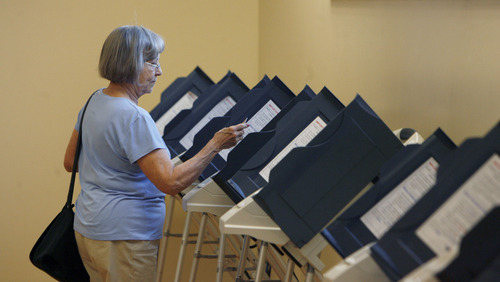This is an archived article that was published on sltrib.com in 2012, and information in the article may be outdated. It is provided only for personal research purposes and may not be reprinted.
More than 76,000 Utah voters have been dropped off the voter rolls this year in a move that Democrats in the state say smells fishy, but elections officials say it's a routine housecleaning move.
"We're tremendously concerned about it. It really is a very, very serious issue," said Utah Democratic Party Chairman Jim Dabakis.
He said if it is simply a clean-up of inactive voters, it should have been done more incrementally instead of dropping off tens of thousands in an election year.
"We're worried there's something more nefarious, and I'm not convinced this isn't all part of a kind of Karl Rove plot to guarantee what [Republicans] really want, which is complete domination," Dabakis said. "It should be scary to every single reasonable person in the state."
But state and county elections officials say there is no grand conspiracy at play.
"There didn't seem to be anything unusual. It just looked like they [county clerks] were going through and cleaning up what they could and making sure it was ready for this upcoming election," said Mark Thomas, director of the state's elections office.
The vast majority of those who have been moved off the voter roles have been in Salt Lake County, where officials shifted about 60,000 voters to an "inactive status" if they hadn't voted or signed a petition in the past several elections. An additional 30,000 who hadn't participated in between eight and 12 years were moved to "hold" status, meaning their names stay in the system, but they are not included in the official voter rolls sent to polling places.
Before either change is made, the clerk sent a postcard to the registered voters' addresses, notifying them that their status could be changed, said Sherrie Swensen, the Salt Lake County Clerk, who is a Democrat.
Even those on an inactive or hold status are not off the rolls completely. A voter can cast a provisional ballot, which would be counted if he or she had been registered before.
"We would seriously be shocked if these people showed up, but if they did we would still allow them to vote, at least provisionally," said Swensen. "No one has expressed any concern to us. We've given them every benefit of the doubt. We've kept them on even longer than we would need to."
The county's most recent round of culling the rolls took place in July.
Democrats in battleground states around the country have expressed concerns about the way those states are going about purging voter rolls and enacting new voter-identification laws, which the party says disproportionately hinder Democrats from voting.
Utah Republican Party Chairman Thomas Wright said he thinks the processes for managing the list are appropriate.
"You hate to see anybody removed from the list, but you have to balance that with making sure the lists are accurate," he said. "The protections for those who may have inadvertently been removed are adequate."
He said during voter-registration drives that the party conducted, he has knocked on doors of homes that have seen two or three different owners since the registered voter moved out.
"I think it's important that we keep these lists accurate. Otherwise, it makes it really hard to campaign and makes the system ripe for fraud," he said.
gehrke@sltrib.comTwitter: @RobertGehrke



